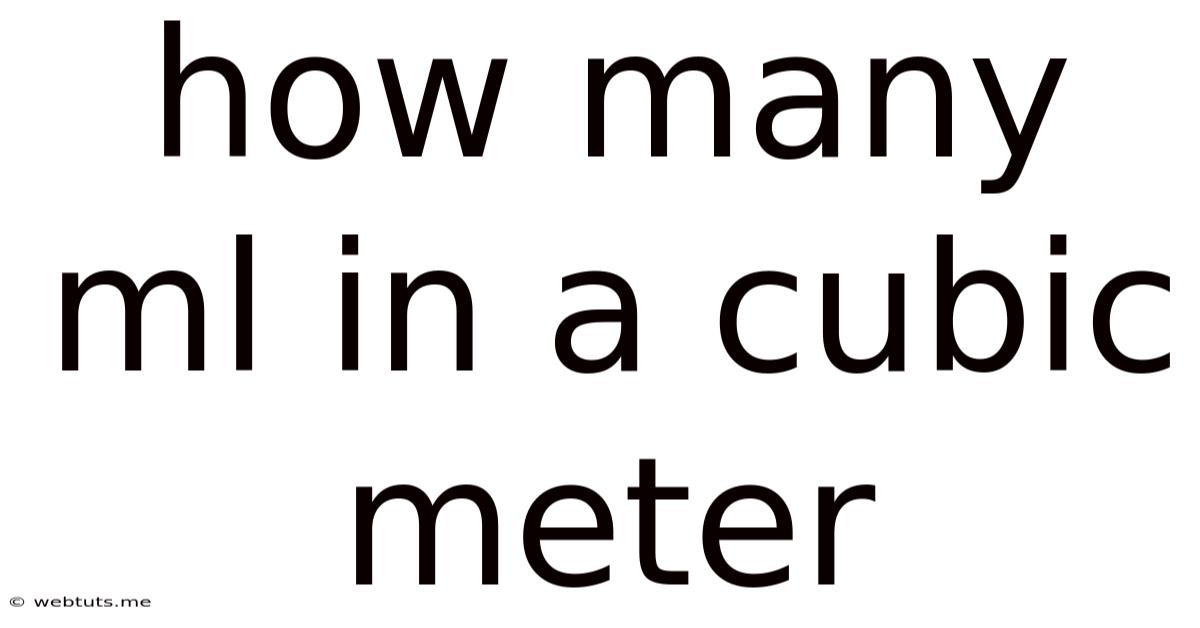How Many Ml In A Cubic Meter
Webtuts
May 10, 2025 · 4 min read

Table of Contents
How Many Milliliters in a Cubic Meter? A Comprehensive Guide
Understanding unit conversions is crucial in many fields, from engineering and science to everyday cooking and DIY projects. One common conversion that often causes confusion is determining how many milliliters (mL) are in a cubic meter (m³). This comprehensive guide will break down this conversion, explore its practical applications, and provide you with the tools to confidently perform similar conversions in the future.
Understanding the Units
Before diving into the conversion, let's establish a clear understanding of the units involved:
-
Milliliter (mL): A unit of volume in the metric system. It's a relatively small unit, commonly used for measuring liquids like water, milk, or medicine. Think of a small bottle of eyedrops or a teaspoon – these often hold a few milliliters.
-
Cubic Meter (m³): A unit of volume representing a cube with sides of one meter each. This is a significantly larger unit of volume, often used for larger quantities of materials or spaces like rooms, storage containers, or even swimming pools.
The Conversion Factor: Unveiling the Relationship
The key to converting between milliliters and cubic meters lies in understanding the relationship between the base units of the metric system. The metric system, also known as the International System of Units (SI), is based on powers of 10, which makes conversions relatively straightforward.
Here's the crucial connection:
-
1 cubic meter (m³) is equal to 1,000,000 cubic centimeters (cm³).
-
1 cubic centimeter (cm³) is equal to 1 milliliter (mL).
Therefore, we can establish the conversion factor:
1 m³ = 1,000,000 mL
This means that one cubic meter contains one million milliliters. This significant difference highlights the vast difference in scale between these two units.
Step-by-Step Conversion: A Practical Approach
Let's solidify our understanding with a practical example. Imagine you need to fill a 2.5 cubic meter water tank. How many milliliters of water will that require?
1. Start with the given volume in cubic meters: 2.5 m³
2. Apply the conversion factor: Multiply the volume in cubic meters by 1,000,000 mL/m³
Calculation: 2.5 m³ * 1,000,000 mL/m³ = 2,500,000 mL
Therefore, you would need 2,500,000 milliliters of water to fill the 2.5 cubic meter tank.
Beyond the Basics: Expanding Your Conversion Skills
The conversion between cubic meters and milliliters is a fundamental step in mastering unit conversions within the metric system. This understanding can be extended to other units of volume as well. Here are some related conversions you might find useful:
Converting Liters to Cubic Meters
- 1 cubic meter (m³) = 1000 liters (L)
This means if you know a volume in liters, you can easily convert it to cubic meters by dividing by 1000. Conversely, to convert cubic meters to liters, you would multiply by 1000.
Converting Cubic Centimeters to Milliliters
- 1 cubic centimeter (cm³) = 1 milliliter (mL)
This is a direct equivalence. One cubic centimeter of volume occupies the same space as one milliliter.
Converting Cubic Millimeters to Milliliters
- 1 milliliter (mL) = 1000 cubic millimeters (mm³)
This highlights the relationship between cubic millimeters and milliliters. You would divide the volume in cubic millimeters by 1000 to find the equivalent volume in milliliters.
Practical Applications: Where This Conversion is Used
Understanding the conversion between cubic meters and milliliters is valuable in a wide range of applications:
- Water Management: Calculating water storage capacity in tanks, reservoirs, or swimming pools.
- Engineering: Determining the volume of materials used in construction or manufacturing.
- Environmental Science: Measuring water pollution levels or analyzing soil composition.
- Medicine: Calculating dosages of liquid medications or determining the volume of intravenous fluids.
- Food and Beverage Industry: Measuring the volume of liquids during production and packaging.
- Aquariums: Calculating the appropriate water volume for fish tanks.
- Agriculture: Determining the amount of irrigation water needed for crops.
Troubleshooting Common Mistakes
When performing these conversions, be mindful of these common errors:
- Incorrect Conversion Factor: Double-check that you're using the correct conversion factor (1 m³ = 1,000,000 mL). Using the wrong factor will lead to an inaccurate result.
- Unit Mismatch: Ensure that your initial volume is correctly expressed in cubic meters. If it's in liters or another unit, perform the necessary conversions first before converting to milliliters.
- Calculation Errors: Carefully perform the multiplication or division to avoid simple arithmetic mistakes. Using a calculator can minimize this risk.
Conclusion: Mastering Unit Conversions for Success
The ability to seamlessly convert between different units of volume is an essential skill in various fields. Understanding the relationship between cubic meters and milliliters, along with related conversions, equips you to tackle numerous practical problems accurately and efficiently. By mastering this conversion, you enhance your problem-solving capabilities and contribute to greater precision in your work. Remember the fundamental conversion: 1 cubic meter equals one million milliliters, and use this knowledge to confidently navigate future volume calculations.
Latest Posts
Latest Posts
-
7 Cups Of Water Is How Many Ounces
May 10, 2025
-
Tablespoons Of Butter In 2 3 Cup
May 10, 2025
-
How Many Days Ago Was July 27th
May 10, 2025
-
How Many Liters Is One Pint
May 10, 2025
-
How Many Days Till July 29 2024
May 10, 2025
Related Post
Thank you for visiting our website which covers about How Many Ml In A Cubic Meter . We hope the information provided has been useful to you. Feel free to contact us if you have any questions or need further assistance. See you next time and don't miss to bookmark.